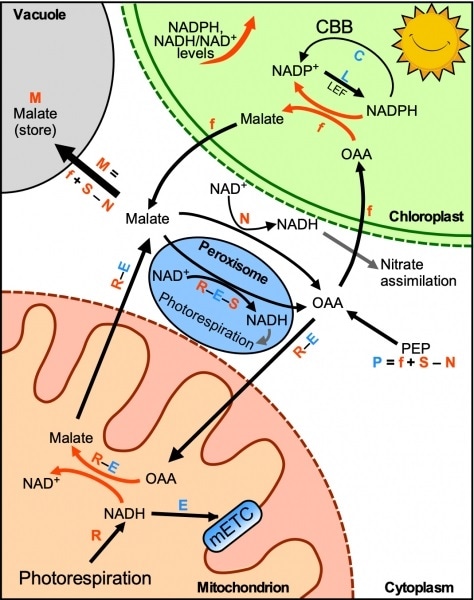The research team of Dr Boon Leong LIM, an Associate Professor of the School of Biological Sciences of The University of Hong Kong, has devised novel approaches to observe energy changes that occur in subcellular compartments in live plants.

Malate flow during C3 photosynthesis. Image Credit: University of Hong Kong.
Two years ago, the same team had demonstrated how chloroplasts improve its energy efficiency.
Now, the researchers have solved a debatable question relating to photosynthesis—what is the source of Reduced Nicotinamide adenine dinucleotide (NADH) for mitochondria to produce Adenosine triphosphate (ATP). The findings were recently published in the Nature Communications journal.
Photosynthesis is a process in which light is used as an energy source for plant chloroplasts to produce carbohydrates from water as well as carbon dioxide (CO2) molecules. ATP plays a significant role in this process, since it supplies energy for numerous cellular activities and also promotes the growth of plants.
Since 1969, It was generally believed that mature plant chloroplasts can import ATP from cytosol. However, this assumption was shown to be incorrect by Dr Lim and his research team back in 2018, and they demonstrated this by introducing a new ATP sensor in the subcellular compartments of a C3 plant model Arabidopsis thaliana.
This discovery has revised one’s understanding of chloroplast bioenergetics during both daytime and nighttime and how energy efficiency is optimized by mature chloroplasts.
Yet another unanswered issue relating to photo-energy is that the source of NADH as a fuel for mitochondria—the main ATP synthesizing organelle present in cells—to synthesize ATP during photosynthesis is still unclear.
A few scientists proposed that surplus reducing equivalents carried by excess Reduced Nicotinamide adenine dinucleotide phosphate (NADPH) can be transported to the cytosol in the form of malate, which can subsequently penetrate mitochondria via the malate-OAA shuttle and get converted into NADH and OAA in the mitochondrial matrix.
By contrast, a few scientists suggested that at the time of photorespiration, glycine decarboxylase produces a huge quantity of NADH in mitochondria for the production of ATP, and that excess reducing equivalents carried by NADH are exported to the cytosol by the mitochondrial malate-OAA shuttle.
In the above two routes, the directions of the malate-OAA shuttle over the mitochondrial membrane at the time of photosynthesis are opposite to one another, and hence, this problem had been a subject of intense discussion.
To address this problem, Dr Lim’s team introduced two innovative sensors that quantify real-time dynamic variations in NADPH levels as well as NADH/NAD+ ratios—this ratio reflects the oxidation and reduction status of the cellular compartments—in Arabidopsis thaliana.
The traditional detection techniques need extraction and purification of plant metabolites and also determination by chemical techniques. Such techniques have certain disadvantages, for example, real-time dynamic measurement and in planta measurement is not possible; these methods are incapable of measuring the energy molecules in various types of cell or different subcellular compartments.
Our novel technique solves all of the problems above. By employing these energy sensors, we found that photorespiration supplies a large amount of NADH to mitochondria during photosynthesis, which exceeds the NADH-dissipating capacity of the mitochondria. Consequently, the surplus NADH must be exported from the mitochondria to the cytosol through the mitochondrial malate-OAA shuttle.”
Shey-Li Lim, PhD Student, School of Biological Sciences, University of Hong Kong
Lim is also the first author of a paper published in the Nature Communications journal.
Lim continued, “Solving this question allows us to understand more about the energy flow between chloroplasts and mitochondria during photosynthesis, which could help us to booth the efficiency of photosynthesis in the future.”
We are the first group to introduce these three novel energy sensors in plants. They will have wide applications in researches regarding plant bioenergetics. Now we are employing them to study bioenergetics of guard cells, pollen tube growth and C4 plants with international collaborators.”
Dr Boon Leong Lim, Associate Professor, School of Biological Sciences, The University of Hong Kong
“It is a great satisfaction to revisit and clarify some general believes in my field. I wish our findings can eventually help humans to boost agriculture production,” Dr Lim concluded.
Source:
Journal reference:
Lim, S.-L., et al. (2020) In planta study of photosynthesis and photorespiration using NADPH and NADH/NAD+ fluorescent protein sensors. Nature Communications. doi.org/10.1038/s41467-020-17056-0.